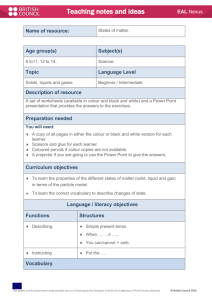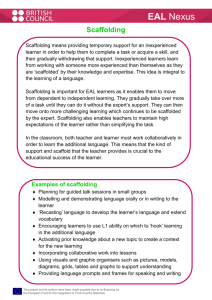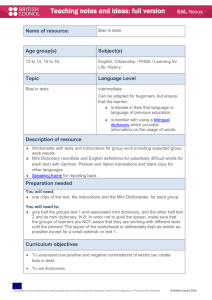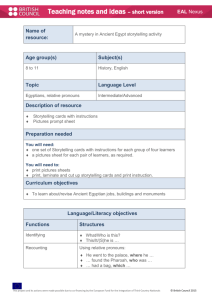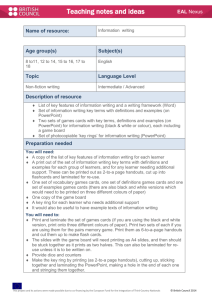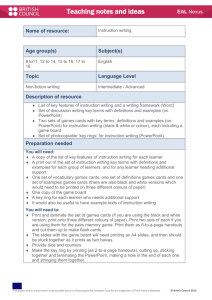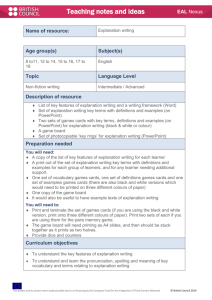in Word - Introducing new vocabulary
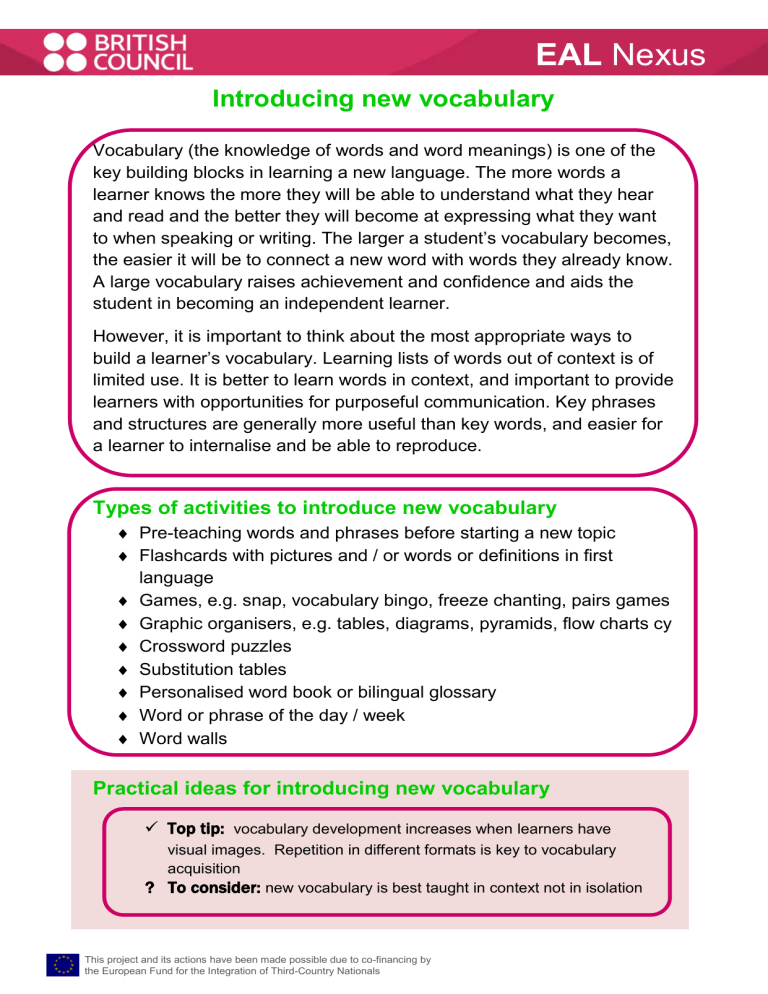
EAL Nexus
Introducing new vocabulary
Vocabulary (the knowledge of words and word meanings) is one of the key building blocks in learning a new language. The more words a learner knows the more they will be able to understand what they hear and read and the better they will become at expressing what they want to when speaking or writing. The larger a student’s vocabulary becomes, the easier it will be to connect a new word with words they already know.
A large vocabulary raises achievement and confidence and aids the student in becoming an independent learner.
However, it is important to think about the most appropriate ways to build a learner’s vocabulary. Learning lists of words out of context is of limited use. It is better to learn words in context, and important to provide learners with opportunities for purposeful communication. Key phrases and structures are generally more useful than key words, and easier for a learner to internalise and be able to reproduce.
Types of activities to introduce new vocabulary
Pre-teaching words and phrases before starting a new topic
Flashcards with pictures and / or words or definitions in first language
Games, e.g. snap, vocabulary bingo, freeze chanting, pairs games
Graphic organisers, e.g. tables, diagrams, pyramids, flow charts cy
Crossword puzzles
Substitution tables
Personalised word book or bilingual glossary
Word or phrase of the day / week
Word walls
Practical ideas for introducing new vocabulary
Top tip: vocabulary development increases when learners have visual images. Repetition in different formats is key to vocabulary acquisition
? To consider: new vocabulary is best taught in context not in isolation
This project and its actions have been made possible due to co-financing by
This project and its actions were made possible due to co-financing by the the European Fund for the Integration of Third-Country Nationals
Third-Country Nationals.
EAL Nexus
Pre teaching words:
Before the main lesson begins put key words with visuals and definitions on the whiteboard and give learners time to read / write the words / look them up in a bilingual dictionary then refer to their list during the lesson.
Alternately give handouts the week before the lesson as homework.
Games:
The best games to use are ones where a phrase or structure is repeated rather than just a word. For example:
Snap: (using flashcards with a word and picture on), before a player can win the pile of cards they have to say a sentence containing the word, th e word’s opposite (using the sentence ‘the opposite of
______ is _____’) or a synonym (‘Another word for ________ is
_______).
Vocabulary bingo: learners work in teams and the winning team has to make sentences that include all the words
I went to market and I bought _______: the memory game where a phrase is repeated can be used with a range of different structures, e.g. I am a scientist and I can use (a Bunsen burner / a Newtonmeter
/ a thermometer / a test tube)
Freeze chanting: works well with younger learners, using verbs and phrases containing verbs (e.g. peeling a banana, eating an apple, chopping up onions). Learners walk around the room, the teacher calls out the phrase and the learners chant the phrase and mime it if possible until the teacher calls out stop.
Matching games: these can be done with phrases as well, matching real objects or pictures to phrases, or words to phrases
Personalised word book / bilingual glossary : each learner has their own word book where they can write down all their new vocabulary arranged either alphabetically or by subject. This could include space to write words from their first language, synonyms and antonyms, pictures and the word used in a sentence. If it is a bilingual glossary then the learner should be encouraged to write the definition in their first language, rather than just the word. If you are introducing vocabulary that is likely to be new to all members of the class, such as subject specific or technical vocabulary, then the EAL learner is
This project and its actions have been made possible due to co-financing by
This project and its actions were made possible due to co-financing by the the European Fund for the Integration of Third-Country Nationals
Third-Country Nationals.
EAL Nexus also unlikely to know the word, or understand the concept, in their first language, so a translation of the explanation is more useful.
Word of the week : Learners commit to using the word or phrase as often of possible during the week and report back the following week.
This can be integrated into the school’s reward system, e.g. house points or merits earned for correct use of the word in writing or orally in class.
Word walls : this is a display in the classroom where new vocabulary with visuals is displayed in an interesting and meaningful way to help students see patterns and relationships in words and to support vocabulary development. It should be in a prominent place and referred to as often as possible.
Translations into different languages included in the word wall gives a clear message that first languages are valued.
Bilingual dictionaries: learners who are literate in their first language should be given opportunities to use a high quality bilingual dictionary. See bilingual dictionaries and translation software.
Good for EAL, Good for All:
Can I use these ideas with the whole class?
Yes, learning new vocabulary is not only important for beginners.
Advanced EAL learners and learners with English as a mother tongue need to acquire the more formal vocabulary and register required for academic success and will benefit from these teaching and learning strategies.
This project and its actions have been made possible due to co-financing by
This project and its actions were made possible due to co-financing by the the European Fund for the Integration of Third-Country Nationals
Third-Country Nationals.
